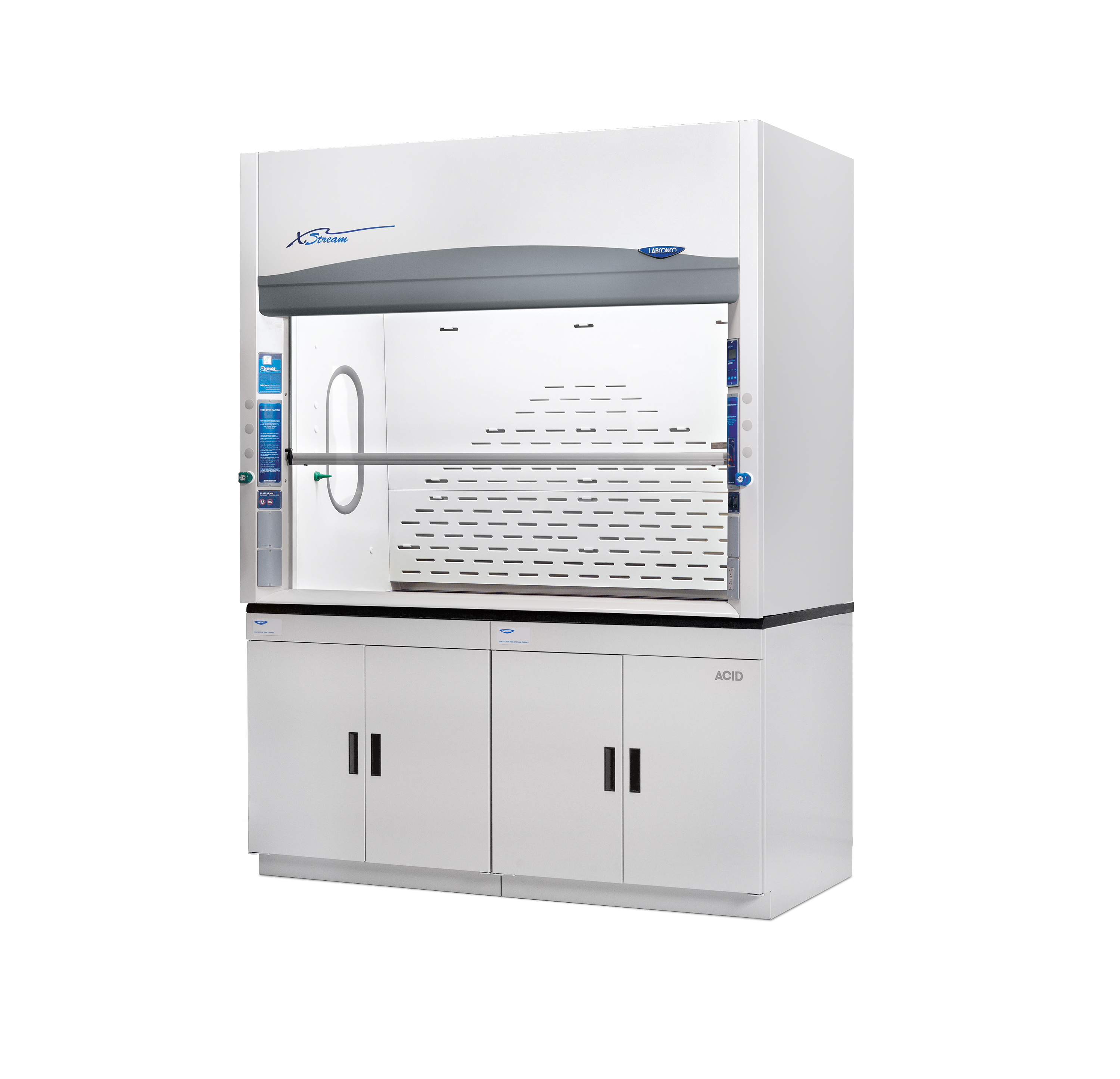What's the difference between a fume hood, biosafety cabinet and laminar airflow bench?

Primary engineering controls like fume hoods, biosafety cabinets and laminar flow benches are referred to as "hoods", “fume hoods”, “cell culture hoods” or “laminar flow hoods” yet each are entirely different categories of laboratory equipment, and multiple enclosure types can often fall under these general terms. Knowing the type of enclosure you need, and knowing the terminology helps ensure personnel and procedures are safe. Each type of hood is built to safely handle the laboratory hazards for which it is designed, but they differ in terms of the type(s) of protection provided, airflow patterns and suitable applications.
In short, fume hoods are ventilated enclosures that protect personnel by removing hazardous chemical fumes and volatile vapors from the work area by exhausting the air outside. Biological safety cabinets (or biosafety cabinets or BSCs) utilize HEPA filters to provide environmental, personnel and product protection from hazardous particulates like bacteria and viruses and typically recirculate filtered air back to the lab (depending on Type). Laminar flow workstations also utilize HEPA filters, but only protect the application or product, not the personnel.

If tasked with selecting a "hood" for a laboratory, below are some common points for consideration. As improper selection or use of equipment can yield significant consequences for health and safety, always consult your safety officer or industrial hygienist for recommendations based on your specific applications. The enclosure you select for various laboratory applications should be listed in the chemical hygiene plan and/or outlined in the biological risk assessment.
Protection
The first questions to ask when selecting between the different enclosures is who/what are you trying to protect and what are you needing protection from (fume vs particulate). Fume hoods provide personnel protection from chemical fumes and vapors. Biosafety cabinets provide environmental, personnel and product protection from hazardous particulates and biohazards, but do not protect against fuming chemicals (depending on Type) Laminar airflow clean benches provide product protection from environmental contaminants, but do not protect the user.
Airflow
Fume hood airflow
Because fume hoods handle hazardous chemicals (see Applications below), air is drawn away from the laboratory worker beginning at the face of the equipment, across the work surface and through ductwork where it is released and diluted into the atmosphere.
Proper and undisrupted airflow is critical within a fume hood; do not store large equipment inside the hood or do anything that could otherwise disrupt the movement of air within the unit. To maintain a safe and efficient work environment, never put your head inside the hood and keep the sash closed as much as possible.
For more information: Video: Labconco Fume Hood Airflow Demonstration
Biosafety cabinet airflow
The three main classes of biosafety cabinets all have one feature in common: HEPA filtration.
- In a Class I biosafety cabinet, air is drawn away from the laboratory worker and across the work surface. This provides protection to the operator, but not to the product as unfiltered room air enters the cabinet.
- In a Class II biosafety cabinet, intake air is drawn safely around the operator and flows under the worksurface (providing personnel protection) and HEPA filtered air flows downward onto the work surface (providing product protection). The exhaust air is HEPA filtered before it is either recirculated into the laboratory or released into the atmosphere through ductwork or a canopy connection (providing environmental protection).
- Class III biosafety cabinets are gas-tight enclosures, with both intake air and exhaust air passing through HEPA filtration. These cabinets also provide a physical barrier between the operator and the sample.
For more information on the different biosafety cabinet types:
Article: What are the biosafety cabinet classes?
Video: Airflow in a Class II, A2 Purifier® Logic®+ Biological Safety Cabinet
Laminar flow cleanbench airflow
Laminar flow clean benches and workstations (a.k.a. clean benches and laminar flow hoods) provide product protection by directing clean, HEPA filtered air across the worksurface and towards the laboratory worker. As no personnel protection is provided by this type of enclosure, applications and use is only for non-hazardous processes requiring a clean environment. There are two common variations.
- Horizontal: Air is pushed through a HEPA filter and is directed horizontally across the worksurface, from back to front, towards the operator.
- Vertical: Air is pushed through a HEPA filter and is directed vertically from the top of the enclosure, from top to bottom, towards the operator.
For more information: Article: Differences between horizontal and vertical clean benches
Applications
- Fume hoods: Chemical fume hoods can be used to handle the following: odorous materials, toxic gases, reactive materials, corrosive chemicals, flammables or other toxic and volatile materials.
- Biosafety cabinets: Biosafety cabinets provide a safe environment for research involving infectious microorganisms or other hazardous particulates. Depending on the type of cabinet (see below), these enclosures are suitable for use with agents requiring containment in conjunction with Biosafety Level (BSL) 1, 2 or 3. (Note that Class III cabinets can accommodate BSL 4 agents. Class II cabinets can accommodate BSL 4 applications with proper personnel protective equipment.)
- Laminar airflow workstations: Clean benches provide a clean working environment for non-hazardous processes such as media preparation, plant tissue culture, sterile non-hazardous work, electronics and other sensitive equipment.
Variations
- Fume hoods: By-pass chemical fume hoods are the most common type, operating at a constant air volume. Reduced air volume and high performance fume hoods all fall under the by-pass chemical fume hood umbrella. High performance fume hoods operating on a variable air volume (VAV) system are the most efficient. Fume hoods exist for special circumstances as well, such as those particularly suited to handle perchloric acid (constructed of acid resistant materials), acid digestions and radioactive applications (constructed with extra decontamination features and often require filters in ductwork). Ductless fume hoods that utilize carbon filtration are also available.
-
Biosafety cabinets: Class I biosafety cabinets have sash and work opening, operate under negative pressure and do not provide product protection. Class II biosafety cabinets (the most common), fall under three main categories—Type A, Type B, and Type C. Class II, Type A cabinets recirculate air back into the laboratory unless they are canopy connected to the outside as required by the application (work with odorous materials). Class II, Type A1 and A2 cabinets are similar yet separated by the minimum average inflow velocity (fpm) required, and neither type can handle work involving radionuclides or volatile chemicals.
Class II, Type B cabinets, on the other hand, are hard ducted to laboratory exteriors and are suitable for work with some hazardous chemicals if required by the microbiological studies being performed in the interior of the equipment. Class II, Type B1 biosafety cabinets recirculate a percentage of air back into the laboratory while Class II, Type B2 cabinets are entirely hard ducted. Class II, Type B cabinets require a dedicated exhaust duct for each cabinet. Class II Type C1 cabinets are a combination of Type A and Type B. Type C1 cabinets are flexible. They can be connected to ductwork when running in Type B mode, or they can recirculate back into the laboratory when setup in Type A mode. Type C1 cabinets do not require a dedicated exhaust run for each cabinet.
- Laminar flow enclosures: Some variations include UV light. This is very useful for molecular applications (DNA/RNA work) where UV is used as a secondary decontamination step to avoid secondary DNA contamination in reactions.
- Other types of enclosures: Other relevant laboratory equipment can include glove boxes and balance enclosures. If your application involves nanoparticulates, there are also enclosure options designed to accommodate these needs.
Carefully selecting the proper enclosure for your intended operation is critical to safety. Using the appropriate equipment helps ensure optimal protection of both the personnel within the laboratory as well as the space itself, and it can also preserve the integrity of your work.
Should you have any questions or need help accessorizing or selecting the correct enclosure for your process, please contact us or reach out to a specialist live on chat (M-F 8AM-5PM CST.) or call us directly at 1-800-821-5525 (M-F 8AM-5PM CST.) and ask for application support.
| chevron_left | Case Study: Athena Mobile Laboratories: A Partnership for Scientific Progress | Articles | Human factors (ergonomics) in clinical lab medicine | chevron_right |






